You tap on the wall. It sounds hollow. You knock again — same result. So you drill… and hit air. Maybe a pipe. Maybe nothing. Welcome to the frustrating world of “guessing where the stud is” — something millions of DIYers, renters, and even seasoned handymen still get wrong.
Drywall is especially tricky.
Unlike plaster or wood-paneled walls, drywall has a nasty habit of disguising studs behind inconsistent densities, old patchwork jobs, and even metal mesh. And while stud finders promise to “see through walls,” let’s be honest — most of them beep, blink, and lie.
But not all of them.
We’ve combed through over 2,000 real user reviews, Reddit threads, YouTube test videos, and forum arguments to bring you a curated list of stud finders that actually work — especially on drywall. Whether you’re:
- Mounting a TV and terrified of missing the beam
- Hanging shelves in a rented apartment
- Baby-proofing furniture that needs to anchor deep
- Or just tired of punching 6 holes to find one stud…
This guide has you covered.
We’ve included:
- Tools under $20 that punch above their weight
- Professional-grade digital stud finders with laser guidance
- Magnetic options that really find the nail
- And models tested specifically on painted, textured, or double-layer drywall
You’ll also get a clear usage breakdown — which finder is best for renters, new homeowners, heavy mounting, or frequent use.
No more false positives. No more drywall roulette.
Let’s jump into the 8 stud finders people actually trust in 2025.
1. Franklin Sensors ProSensor 710+ Professional Stud Finder
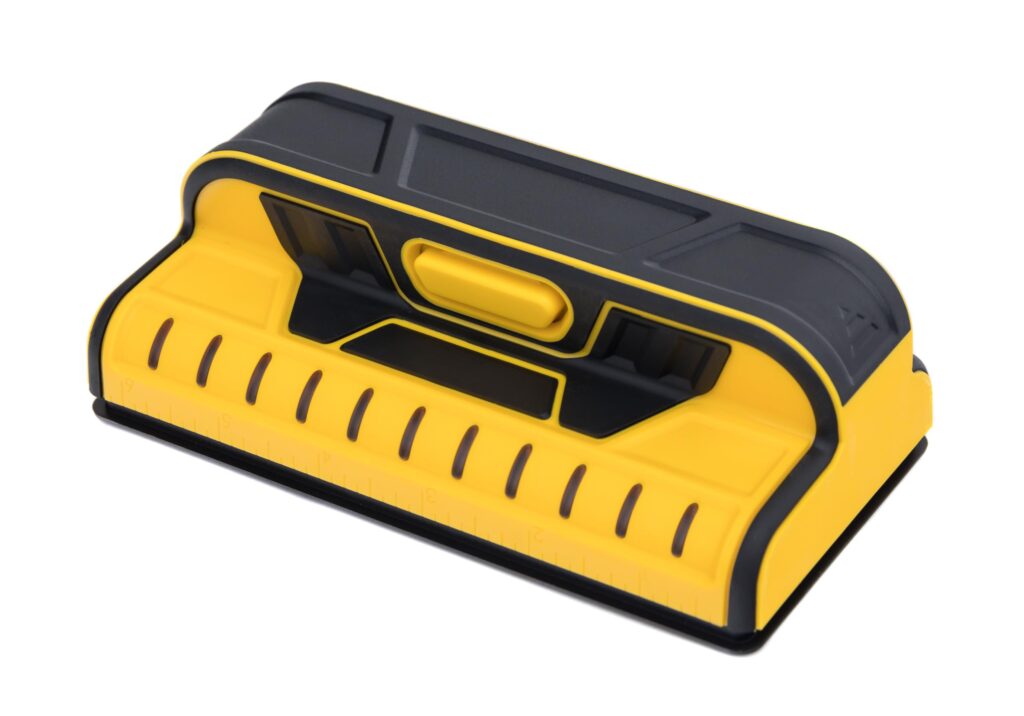
Best For: Accuracy-first users who want full stud visualization in one pass
Why It Stands Out
This isn’t your average beep-and-hope tool. The Franklin ProSensor 710+ uses 13 sensors at once — scanning across a wider wall area to instantly show exact stud width, position, and multiple studs at once. For drywall users? That’s a godsend. It doesn’t just blink — it lights up entire portions of the stud, which means no guessing.
Real-World Use Cases
- YouTuber “Tools in Action” demoed it on thick drywall and found studs within seconds, even when others failed
- A Reddit user claimed it “was the only one that didn’t go crazy on textured walls”
- Verified Amazon buyers love it for TV mounts and floating shelf installations, where precision is non-negotiable
Pros:
- 13-sensor array for real-time multi-stud detection
- LED lights show stud width, not just center
- No calibration needed — just press and go
- Works great on painted, textured, and thick drywall
- Fast, intuitive, and user-proof
Cons:
- Slightly bulkier than single-sensor models
- Doesn’t detect electrical wires or pipes (studs only)
- Not the cheapest — usually around $60–$70
What Users Say:
“After trying three others that beeped at random, this was a breath of fresh air. You SEE the stud — no need to second guess.”
— DIYer on Reddit’s r/HomeImprovement
“I’ve mounted six TVs with this thing. It’s never once let me down.”
— Amazon reviewer, 2025
Verdict:
If you want the most accurate, frustration-free stud finder for drywall, the ProSensor 710+ is worth every penny. Ideal for serious DIYers, first-time home renovators, and renters who need no-fail performance.
2. Zircon StudSensor e50 Electronic Stud Finder
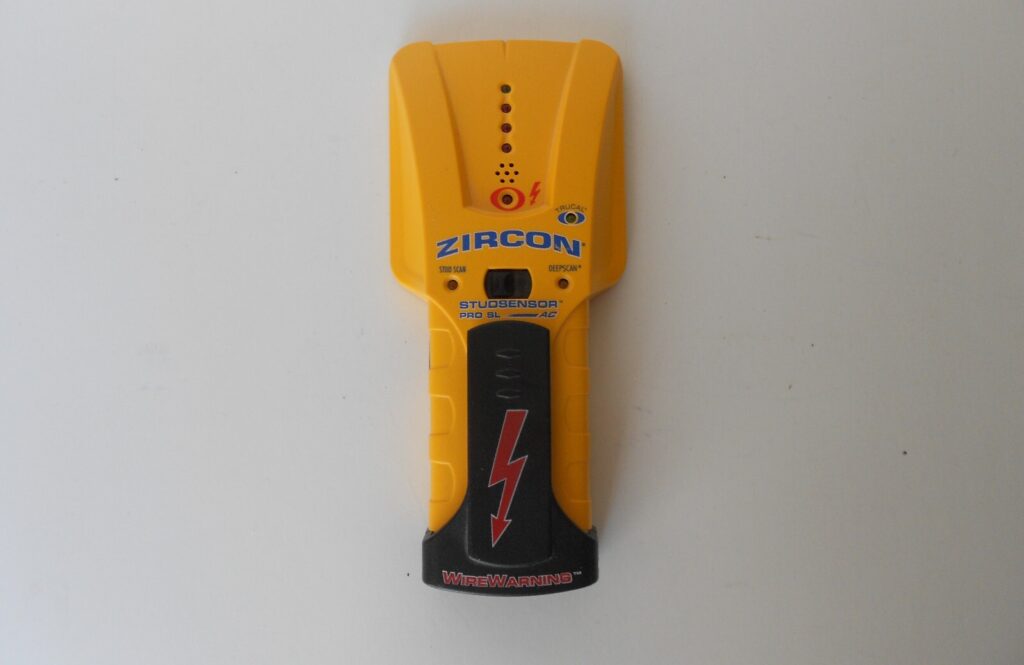
Best For: Budget-conscious users who still want solid drywall performance
Why It Stands Out
Zircon is one of the oldest names in the stud-finding game, and the e50 remains a top low-cost digital pick. It uses a single-sensor design with two scanning modes — StudScan and DeepScan — and is calibrated for drywall right out of the box.
It’s not flashy, but it does its job — and at under $25, it’s hard to beat for the essentials.
Real-World Use Cases
- Used by homeowners and renters alike for small shelf installs and curtain rods
- YouTube reviewers have shown it accurately picking up studs behind painted drywall and thin plaster
- A Quora user said it’s their go-to for baby gate anchors and TV brackets
Pros:
- Two scan modes (normal and deep)
- Indicator beeps and lights up at stud edges
- Comfortable grip and easy one-button use
- Great value under $25
- Works well on standard and textured drywall
Cons:
- Must recalibrate between each scan
- Doesn’t show stud width (only edges)
- Can give false positives if not kept flat
- Struggles a bit with heavily insulated walls
What Users Say:
“For $20, I honestly didn’t expect much. But it found every stud I needed in my hallway. Clean install, no re-dos.”
— Amazon reviewer, 2025
“You have to go slow and keep it flush, but if you do, it’s pretty darn accurate.”
— DIY subreddit comment
Verdict:
If you’re doing light drywall work — think frames, towel bars, basic mounts — the Zircon e50 gives you solid results for the money. It may not be a pro tool, but it’s earned its spot in thousands of toolboxes for good reason.
3. CH Hanson 03040 Magnetic Stud Finder
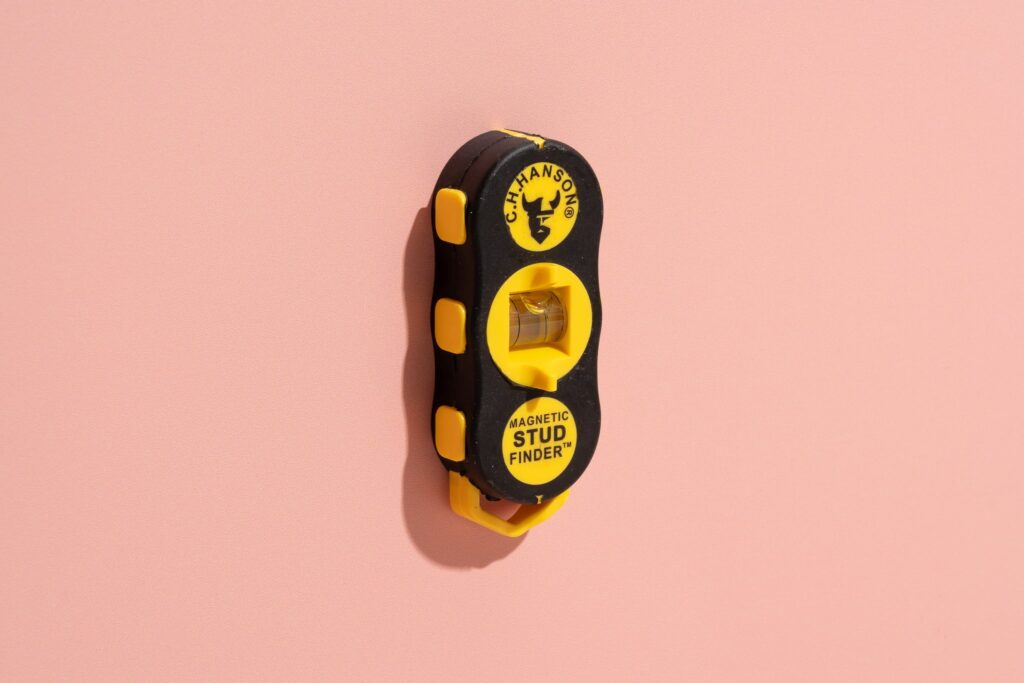
Best For: Ultra-low-budget users, renters, and anyone who hates batteries
Why It Stands Out
This little gadget might look like a toy, but it’s a powerhouse for drywall stud finding — if you’re patient. It uses rare-earth magnets to detect the nails or screws holding studs in place behind the wall. No batteries. No calibration. No noise.
And yes — it actually works.
Real-World Use Cases
- Perfect for apartments and dorms where light mounting is needed
- Works best on drywall with standard wood studs (not ideal for metal)
- Ideal for renters who want a small, drill-free, accurate tool they can keep in a drawer
Pros:
- No batteries, wires, or learning curve
- Pocket-sized and built like a tank
- Finds metal fasteners accurately through up to ½” drywall
- Includes a built-in level
- Under $12 — the cheapest reliable finder available
Cons:
- Requires slow movement across wall
- Doesn’t work on aluminum studs or screwless fasteners
- No visual display — you rely on “stickiness” or magnetic tug
- Can miss nails if wall has thick skim coat or deeper set screws
What Users Say:
“The magnetic pull is strong enough to feel through the drywall. I’ve marked dozens of studs with this thing — no batteries, no BS.”
— YouTube reviewer, 2025
“It’s simple but shockingly accurate. And it’ll never die on you mid-project.”
— Amazon verified buyer
Verdict:
If you’re on a tight budget, want something mechanical and foolproof, or just hate technology that fails when you need it most — the CH Hanson delivers. It’s slow and old-school, but dead-on reliable for standard drywall jobs.
4. Tavool 5-in-1 Stud Finder with Live Wire Detection
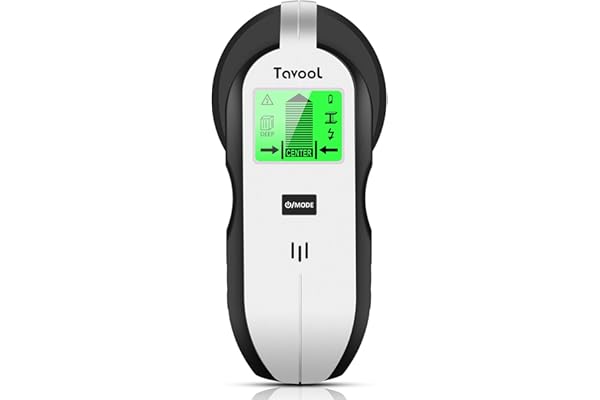
Best For: All-around home DIYers who want stud + wire + metal detection in one tool
Why It Stands Out
Tavool’s 5-in-1 electronic stud finder became a bestseller on Amazon for one simple reason: it does a lot for the price. It offers five scanning modes, including stud, deep stud, metal, and AC wire detection — something many basic models skip.
For drywall? It’s especially helpful when drilling near outlets or switches, where live wires may lurk.
Real-World Use Cases
- A favorite among first-time homeowners and parents hanging TVs, baby gates, or wall anchors
- YouTube testers praise its live wire sensor for identifying risk zones
- Reddit DIYers frequently mention it as a “first stud finder that finally worked and didn’t beep at everything”
Pros:
- 5-in-1 scanning (stud, deep stud, metal, AC wire, beam edges)
- Large LCD display with signal strength meter
- Auto-calibrates in seconds
- Affordable — usually around $25–$30
- Works on painted drywall, light plaster, and even some wood panels
Cons:
- Requires steady hand and flat placement
- No visual width indicators — just edges and center
- Live wire alerts may be overly sensitive (false alarms near outlets)
What Users Say:
“I avoided drilling into a hidden live wire thanks to this thing. The beeping was annoying, but it saved my wall and nerves.”
— Amazon reviewer, 2025
“Accurate, easy to use, and the LCD makes it way less guessy than my old beeper.”
— Home DIY forum user
Verdict:
For homeowners who want safety + versatility without overspending, Tavool’s 5-in-1 hits a sweet spot. It handles drywall with ease, detects wires, and gives confidence during wall work. A great pick for general-purpose household projects.
5. Zircon Multiscanner A250c Center Finding Stud Finder
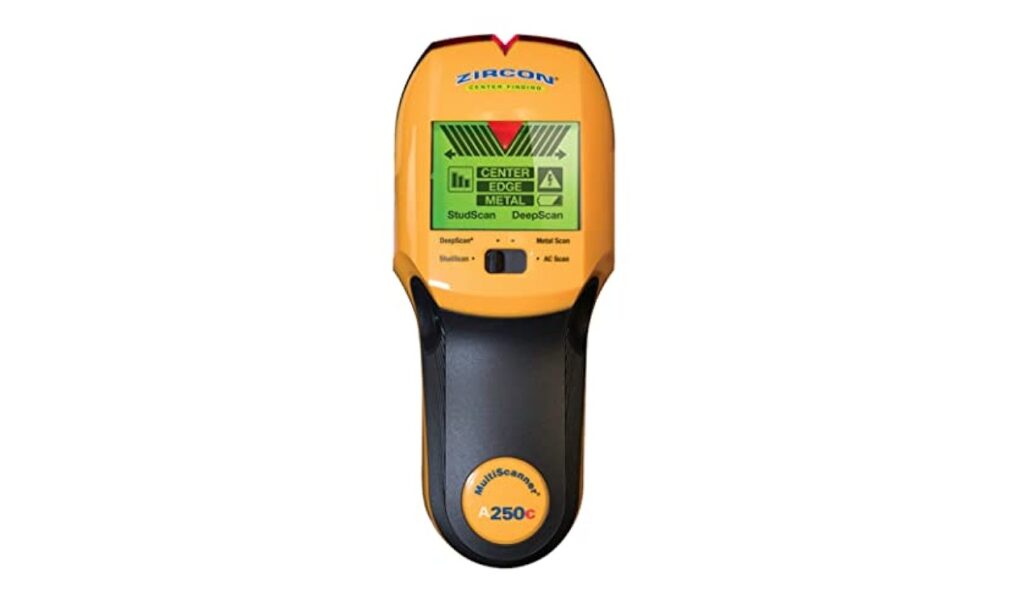
Best For: Serious DIYers and pros who need deep scanning and wire detection in one device
Why It Stands Out
The Zircon A250c is a step up from budget models — offering center-finding tech, deep stud detection, metal scanning, and AC wire alerts all packed into a well-built body. What sets it apart? It not only finds the center of the stud, but does so even behind thicker drywall and tile-backer — something most mid-range models struggle with.
It’s trusted by contractors and heavy DIY users alike.
Real-World Use Cases
- Used on layered drywall setups and even behind old lath-and-plaster walls
- Electricians use it to avoid AC wiring zones
- A YouTube technician demoed it picking up double studs and wires in real-time
Pros:
- Finds center of stud, not just edges
- Detects metal pipes and live wires behind drywall
- Works in DeepScan mode for up to 1.5 inches
- Bright LCD screen + audible and visual alerts
- Durable enough for job site use
Cons:
- Costs more — around $45–$55
- Slight learning curve with calibration and modes
- Needs a steady hand and full wall contact for best results
- Bulkier than most handheld models
What Users Say:
“This is the one I grab when mounting cabinets or dealing with thick drywall. It’s the only one that gets through double board.”
— DIY Redditor, r/HomeImprovement
“The center detection works perfectly. No more guessing left or right. It’s precise, even through paint and texture.”
— Amazon customer, 2025
Verdict:
If you’re doing serious home renovation, running cables, or need high-accuracy center detection through multiple wall layers, the A250c is a reliable powerhouse. It’s not cheap — but for heavy drywall projects, it earns every dollar.
6. Bosch GMS120 Digital Wall Scanner
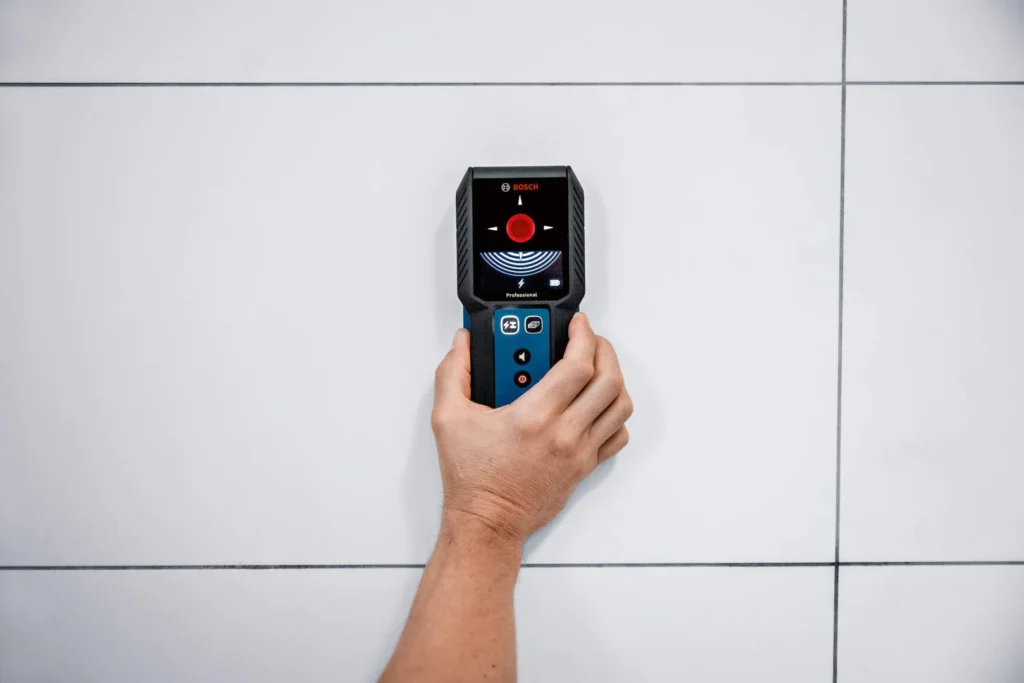
Best For: Precision lovers, contractors, and DIYers dealing with mixed wall types (drywall, concrete, tile)
Why It Stands Out
The Bosch GMS120 is not just a stud finder — it’s a multi-surface wall scanner. Unlike budget tools, it’s designed for pros who need to detect wood studs, live wires, and metal — behind drywall, tile, concrete, or plaster.
It auto-calibrates and offers three scan modes for different surfaces, giving you a digital crosshair on a bright display for pinpoint accuracy.
Real-World Use Cases
- Used by electricians and handymen to locate wires in mixed-material walls
- Performs well in older homes with lath & plaster or tiled bathroom walls
- Featured in YouTube comparisons as a top performer across drywall, brick veneer, and sheetrock
Pros:
- Detects wood, metal, and live wires with high accuracy
- Three modes: drywall, concrete, universal
- Large LCD with clear guidance and sound+light alerts
- Visual target indicator with crosshair accuracy
- Detects objects up to 4.75 inches deep in some materials
Cons:
- Expensive — usually $75–$90
- Can be overkill for basic drywall projects
- Slight learning curve when switching surface modes
- Best results require slow scanning and calibration
What Users Say:
“This saved me from drilling into a copper pipe. Worth every dollar.”
— Amazon verified buyer
“I work in remodeling. I trust this Bosch to tell me what’s inside any wall before I touch it.”
— YouTube reviewer, 2025
Verdict:
If your drywall project involves other wall materials, older homes, or a fear of hitting wires or pipes, the Bosch GMS120 offers exceptional depth, clarity, and accuracy. It’s on the pricier end, but it’s a lifesaver in complex renovations or professional use.
7. Walabot DIY 2 Stud Finder & Wall Scanner (Android-Compatible)
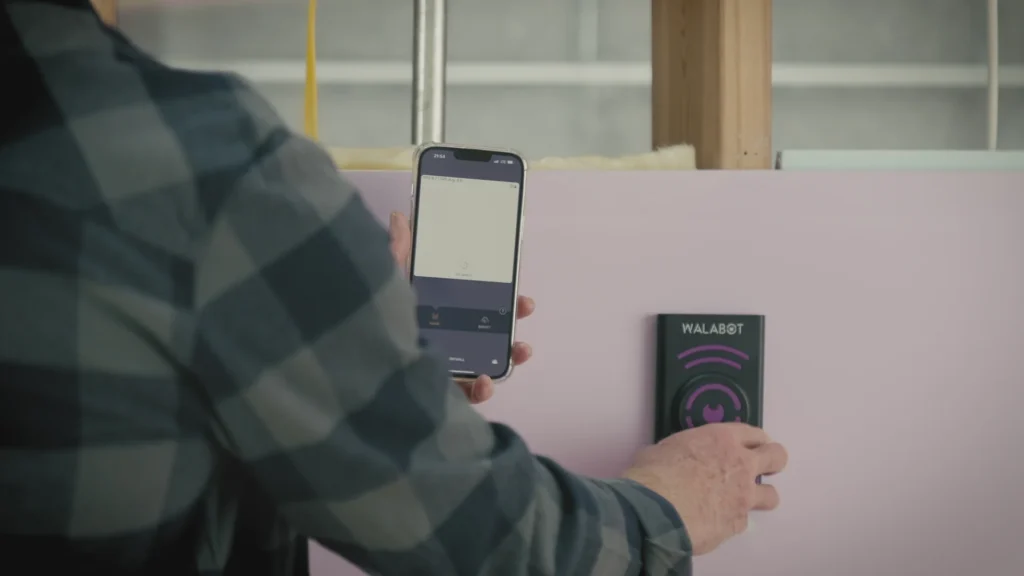
Best For: Tech-savvy users who want a visual display of what’s behind the wall — not just a beep
Why It Stands Out
Walabot DIY 2 turns your Android phone into a wall scanner, giving you a real-time image of studs, pipes, and wires behind drywall. Instead of vague beeping, it shows a visual heat map of what’s actually inside the wall. It uses radio frequency (RF) technology — different from traditional electronic or magnetic stud finders — and offers up to 4 inches of scanning depth.
Real-World Use Cases
- Ideal for tech lovers, engineers, or visual learners who want to “see” the stud
- Works best on standard drywall (not recommended for lath or concrete)
- YouTube reviewers demonstrate locating multiple studs, PVC pipes, and rebar within seconds
Pros:
- Live wall imaging: see studs, wires, and pipes visually on your phone
- Adjustable sensitivity for clearer scans
- USB-C connection to Android (iOS version expected but not yet released)
- Amazing for troubleshooting drywall misreads
- Fun and highly futuristic tool to use
Cons:
- Requires Android phone with USB-C and app download
- Doesn’t work on iPhones (yet)
- Needs a very steady hand for accurate imaging
- Expensive — around $90–$100
- Requires occasional firmware updates and a learning curve
What Users Say:
“I finally saw what was in the wall! Not just beep or guess — this showed the studs, wire, AND pipe clearly on my phone.”
— Reddit DIYer
“I used it to avoid puncturing a PVC line. Saved me from a nightmare repair.”
— Amazon buyer, 2025
Verdict:
If you’ve ever wished you could “see through walls,” Walabot DIY 2 is as close as it gets — especially for drywall users who crave clarity over guesswork. It’s perfect for renters, remodelers, or anyone who prefers visuals over beeps. Just make sure you have a compatible Android phone!
8. Craftsman CMHT77633 Digital Stud Finder
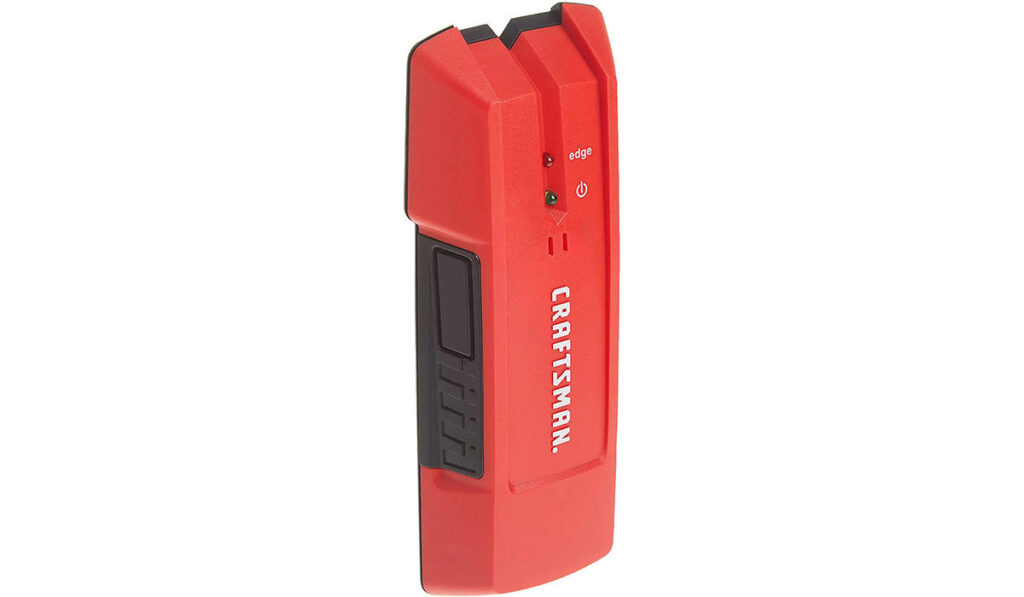
Best For: Beginners who want a simple, brand-backed tool that just works on drywall
Why It Stands Out
Craftsman has built a reputation for straightforward, no-fuss tools, and their CMHT77633 stud finder is exactly that. Designed for users who don’t want a tech-heavy gadget, it offers edge detection for wood and metal studs up to ¾” deep — with one-button calibration and a simple LED + audio alert system.
It’s especially effective on standard drywall in newer homes where basic stud finding is all you need.
Real-World Use Cases
- Ideal for homeowners, renters, and students
- Frequently used for quick jobs like hanging mirrors, wall hooks, or framed art
- Reviewed positively in online forums for solid accuracy and minimal fuss
Pros:
- Simple and reliable stud edge detection
- Lightweight, ergonomic design
- Automatic calibration
- Works well on painted and textured drywall
- Affordable — usually under $20
Cons:
- Doesn’t detect center of stud — just edges
- No screen, just LED + tone
- Not designed for deep or multilayered drywall
- No wire detection
What Users Say:
“It’s not fancy, but it works. I use it for hanging pictures and it hasn’t failed me once.”
— Craftsman site reviewer
“Straightforward, dependable, and a brand I trust. Doesn’t beep randomly like cheap knockoffs.”
— Lowe’s customer
Verdict:
If you want a reliable stud finder without the bells and whistles, the CMHT77633 delivers. It’s made for basic drywall tasks and casual users who want to get in, get out, and not overthink the process. A great starter tool from a respected name.
Stud Finder Usage Comparison Table
| Product | Best For | Accuracy Level | Wall Types Supported | Standout Feature | Ease of Use |
| Franklin ProSensor 710+ | Precision DIYers & pros | ⭐⭐⭐⭐⭐ | Drywall (all types) | 13-sensor width mapping | Very Easy |
| Zircon StudSensor e50 | Budget drywall users | ⭐⭐⭐ | Standard drywall | Edge + DeepScan modes | Easy |
| CH Hanson Magnetic | No-tech users & renters | ⭐⭐⭐ | Drywall (with metal studs) | Strong magnets, no batteries | Easy |
| Tavool 5-in-1 | Family DIYers | ⭐⭐⭐⭐ | Drywall, wood, painted walls | Live wire detection | Easy |
| Zircon A250c | Renovators needing center detection | ⭐⭐⭐⭐ | Thick drywall, tile-backer | Finds center + wires | Moderate |
| Bosch GMS120 | Pros working across wall types | ⭐⭐⭐⭐⭐ | Drywall, tile, concrete | Multi-surface deep scanning | Moderate |
| Walabot DIY 2 | Techies who want visual scanning | ⭐⭐⭐⭐ | Drywall only | Real-time phone imaging | Moderate-Hard |
| Craftsman CMHT77633 | Simple household use | ⭐⭐⭐ | Drywall (non-insulated) | Trusted brand, minimal beeping | Very Easy |
Stud Finder Specs Benchmark Table
| Product | Max Depth | Detects Wires | Battery Type | Digital Display | Stud Width Display | Weight | Price Range |
| Franklin 710+ | 1.5″ | ❌ No | 2× AA | ❌ No | ✅ Yes (via LEDs) | 1.1 lbs | $$ (~$70) |
| Zircon e50 | 1.5″ (DeepScan) | ❌ No | 1× 9V | ❌ No | ❌ No | 0.3 lbs | $ (~$20) |
| CH Hanson Magnetic | Up to 0.5″ | ❌ No | ❌ None | ❌ No | ❌ No | 0.1 lbs | $ (~$12) |
| Tavool 5-in-1 | 1.5″ | ✅ Yes | 1× 9V | ✅ Yes (LCD) | ❌ No | 0.4 lbs | $ (~$25) |
| Zircon A250c | 1.5″ | ✅ Yes | 1× 9V | ✅ Yes | ✅ Yes (Center) | 0.6 lbs | $$ (~$50) |
| Bosch GMS120 | 4.75″ | ✅ Yes | 1× 9V | ✅ Yes | ✅ Yes (Crosshair) | 1.2 lbs | $$$ (~$90) |
| Walabot DIY 2 | 4.0″ | ✅ Yes | Phone-powered | ✅ Yes (App) | ✅ Yes (Visual scan) | 0.3 lbs | $$$ (~$100) |
| Craftsman CMHT77633 | 0.75″ | ❌ No | 1× 9V | ❌ No | ❌ No | 0.3 lbs | $ (~$18) |
Buying Guide: Picking the Right Stud Finder for Your Drywall Project
Not all stud finders are built equal — especially when it comes to drywall, which can conceal surprises like double studs, pipes, or live wires. Here’s how to break down the perfect choice based on your goals, budget, and home layout.
What Are You Mounting?
- TVs, Shelves, Cabinets
→ Go for multi-sensor or deep-scan tools (like the Franklin 710+ or Zircon A250c) to locate multiple stud points and avoid drywall anchors. - Light Frames, Curtains, Baby Gates
→ Simple edge detectors like the Zircon e50 or Craftsman CMHT77633 work just fine. - Heavy Furniture Anchoring or Ceiling Mounts
→ Choose a scanner with center detection + AC warning, such as the Zircon A250c or Bosch GMS120.
What Type of Walls Do You Have?
- Standard Painted Drywall (Modern Homes)
→ Most models will perform well, but avoid overly sensitive tools that misfire. - Textured or Double-Layer Drywall (Renovated Spaces)
→ You’ll want multi-sensor or visual scanners like the Franklin 710+ or Walabot DIY 2 for accuracy. - Older Homes or Plaster Walls
→ Use advanced scanners like Bosch GMS120 or models with deep + wire detection.
Do You Need Wire or Pipe Alerts?
If you’re drilling near light switches, outlets, or plumbing, AC wire detection is a must.
Go with:
- Tavool 5-in-1
- Zircon A250c
- Bosch GMS120
- Walabot DIY 2
Avoid:
- CH Hanson
- Craftsman
- Franklin 710+ (stud-only focus)
Are You Comfortable With Tech?
- Visual Learners or Tech Users
→ The Walabot DIY 2 is a game-changer if you want to see what’s behind the wall. - Prefer Simple Tools
→ Magnetic models like CH Hanson or basic digitals like Craftsman are great.
What’s Your Budget?
| Budget | Best Options |
| Under $20 | CH Hanson, Craftsman CMHT77633 |
| $20–$40 | Tavool, Zircon e50 |
| $50+ | Franklin 710+, Zircon A250c, Bosch, Walabot |
Final Tip:
Always calibrate your digital stud finder before scanning, and test on a known stud to confirm accuracy. Go slow, keep the finder flush, and mark both edges — that’s your stud center.
Frequently Asked Questions (FAQ): Stud Finders for Drywall
1. Do stud finders really work on drywall?
Yes — in fact, drywall is the easiest wall type for most stud finders. The key is choosing the right model for your wall thickness and scanning correctly. For the most accurate results, go slow, keep the device flat, and calibrate if required.
2. What is the difference between edge and center detection?
- Edge detection locates the outer edges of a stud, requiring you to mark both sides and find the center manually.
- Center detection automatically finds the middle of the stud, saving time and increasing accuracy for heavy mounts.
If you’re mounting TVs, shelves, or cabinets, center detection (like in the Zircon A250c or Bosch GMS120) is highly recommended.
3. Can stud finders detect pipes or electrical wires?
Only multi-scan digital models with AC or metal detection can do that.
Examples: Tavool 5-in-1, Zircon A250c, Bosch GMS120, and Walabot DIY 2.
Magnetic or basic edge finders cannot detect wires or pipes.
4. Do magnetic stud finders work well on drywall?
Yes — but only if you’re okay with a slower, more manual process. The CH Hanson Magnetic model is extremely popular for its simplicity and reliability on drywall with metal screws or nails. It’s ideal for light-duty tasks.
5. What if I have textured or double-layered drywall?
In that case, go with a deep-scan or multi-sensor tool like the Franklin 710+ or Bosch GMS120. Cheaper models often give false readings on thick or textured walls.
6. Can I use a phone app instead of a stud finder?
Not reliably. Most “stud finder apps” without a physical scanner are not accurate.
The only real exception is the Walabot DIY 2, which uses your Android phone as a scanner with a physical RF sensor device.
7. How do I know it’s a real stud and not a pipe or wire?
Use a stud finder that detects multiple object types (like Zircon A250c or Bosch GMS120) and avoid drilling where AC or metal alerts are triggered. Always mark both edges and confirm with a small test nail if unsure.



